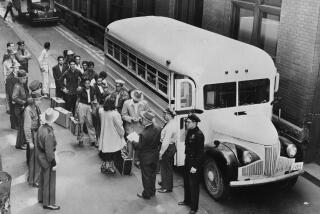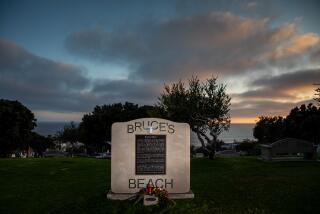Op-Ed: California finally sweeps away most of its tributes to the Confederacy. What took so long?
Over the summer, California underwent a historical reckoning perhaps as comprehensive as any state in the nation. Activists toppled monuments to Confederates, to Spanish missionaries, even to Union generals. Now the process is drawing to a close in a rather unspectacular fashion — not because activists lack the initiative for further action, but because there are almost no monuments left to remove.
That California, a progressive state more than 1,500 miles from the nearest major Civil War theater, would sweep away tributes to dead Confederates seems self-evident. Yet this summer’s rash of monument removals was the culmination of a long-fought and hard-won battle.
Until recently, California housed far more Confederate monuments and place names than any state beyond the South. Other free states contained at most a small handful of rebel tributes, according to the Southern Poverty Law Center’s extensive database. California, in contrast, established more than a dozen such markers over the course of the 20th century.
Californians began fighting over the memory of the Civil War not long after Robert E. Lee surrendered the main rebel army in April 1865. The debate was especially intense in Los Angeles, home to a vocal base of secessionists.
“The Civil War continued to rage” in postbellum Los Angeles, according to Horace Bell, a Union veteran who returned to Southern California shortly after the conflict. When Bell passed by, fellow white Angelenos often spat: “The idea … of a Los Angeles man of your stamp fighting on the side of the Blacks!” According to his own estimates, Bell wound up in as many as 40 brawls for his wartime loyalties. And in 1882, L.A. went so far as to elect a former Confederate army captain as mayor.
Over the coming decades, thousands of white Southern migrants arrived in California. Although they represented a minority of the state’s overall population, they wielded outsized influence in the struggle over Civil War memory. They waged their campaigns through well-funded memorial associations, particularly the United Daughters of the Confederacy.
In 1925, L.A.’s Confederate memorial associations erected the first rebel tribute on the West Coast. The monument, a six-foot granite pillar in Hollywood Cemetery, saluted several dozen Confederate veterans who had moved to Southern California after the war. They were buried in the surrounding cemetery plot.
Several years later, the United Daughters of the Confederacy turned a San Gabriel mansion into the first and only rebel veterans rest home outside the former slave states and territories. They called it Dixie Manor. Some 500 people gathered to celebrate the home’s dedication in 1929.
Controversy had erupted in San Diego several years earlier, when Confederate devotees erected a monument to the Jefferson Davis Highway. It marked the western terminus of a proposed coast-to-coast road system named in honor of the rebel commander in chief.
Almost immediately, Union veterans began protesting. Particularly galling was the fact that the monument sat directly in front of the U.S. Grant Hotel, which had been built by the war hero’s son. The veterans succeeded in having the Davis Highway monument hauled off in 1926, less than a year after it was installed.
But the Confederacy would rise again in San Diego. Roughly three decades later, amid a national controversy over school desegregation, the United Daughters of the Confederacy reinstalled a marker to the Davis Highway. Once again, it stood across from the U.S. Grant Hotel, as if to taunt the old Union commander.
It was one of five highway markers to the rebel president in California.
Shortly thereafter, San Diego named one of its schools for Confederate Gen. Robert E. Lee — the second of its kind within the state. (The first was in Long Beach). By hanging the name of a slaveholder on an educational institution, San Diego rose a not-so-subtle protest to the ongoing process of school integration.
By the early 21st century, California boasted at least 18 Confederate monuments and place names. In addition to his highway markers, Davis also had a peak near Lake Tahoe named in his honor. And along with his two schools, Lee also had four redwood trees named after him. Additionally, California housed the township of Confederate Corners in Monterey County; a scenic network of hills named for the Confederate warship Alabama; a plaque to Robert S. Garnett, the first rebel general killed in the Civil War; and three large stone memorials to the common Confederate soldier in Hollywood, San Diego and Orange County.
The driving force behind California’s rebel landscape, the United Daughters of the Confederacy, had 18 chapters in the state as recently as 1999. For comparison, Ohio and New York — the free states where, after California, the organization was most active — had only three chapters each.
These monuments would, most likely, still be standing if not for a series of violent acts that finally focused public outrage on Confederate commemorations.
Three major flash points inspired an ongoing reckoning with the American past — the murder of nine worshippers at one of the nation’s oldest African American churches in 2015; the white supremacist rally around a statue to Robert E. Lee in Charlottesville, Va., two years later; and the killing of George Floyd in May.
As a result, in California there are no longer any schools named after Robert E. Lee, or peaks after Jefferson Davis, or memorials to Confederate soldiers. Most of the Davis Highway markers are gone as well. Although Lee’s trees still technically bear the rebel general’s name — changing their designation requires approval from Congress or the director of the National Parks Service — identifying signage has been removed.
After nearly a century of debate, California has nearly been purged of its Confederate tributes.
Yet perhaps the most surprising aspect of this history is not that these monuments finally fell during our long, hot summer of protest. It’s that they survived for as long as they did.
Kevin Waite is an assistant professor of history at Durham University in Britain and author of the forthcoming book “West of Slavery: The Southern Dream of a Transcontinental Empire.”
More to Read
A cure for the common opinion
Get thought-provoking perspectives with our weekly newsletter.
You may occasionally receive promotional content from the Los Angeles Times.










